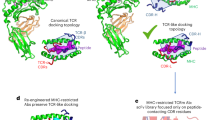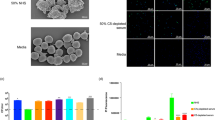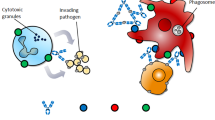Abstract
Here we show that fusion of two complementarity-determining regions (CDRs), VHCDR1 and VLCDR3, through a cognate framework region (VHFR2) yields mimetics that retain the antigen recognition of their parent molecules, but have a superior capacity to penetrate tumors. The antigen-recognition abilities of these ∼3 kDa mimetics surpass those of comparable fragments lacking the framework region. In vivo activities of the mimetics suggests that the structural orientation of their CDRs approximates the conformation of the CDRs in the complex of the parent antibody with antigen. We linked the antibody mimetics to the bacterial toxin colicin Ia to create fusion proteins called “pheromonicins,” which enable targeted inhibition of tumor growth. In mice bearing human malignant tumors, pheromonicins directed against tumor-specific surface markers show greater capacity to target and penetrate tumors than their parent antibodies. Rational recombination of selected VH/VL binding sites and their framework regions might provide useful targeting moieties for cytotoxic cancer therapies.
This is a preview of subscription content, access via your institution
Access options
Subscribe to this journal
Receive 12 print issues and online access
$209.00 per year
only $17.42 per issue
Buy this article
- Purchase on Springer Link
- Instant access to full article PDF
Prices may be subject to local taxes which are calculated during checkout





Similar content being viewed by others
References
Hoogenboom, H.R. Selecting and screening recombinant antibody libraries. Nat. Biotechnol. 23, 1105–1116 (2005).
Borg, N.A. et al. The CDR3 regions of an immunodominant T cell receptor dictate the 'energetic landscape' of peptide-MHC recognition. Nat. Immunol. 6, 171–180 (2005).
Laune, D. et al. Systematic exploration of the antigen binding activity of synthetic peptides isolated from the variable regions of immunoglobulins. J. Biol. Chem. 272, 30937–30944 (1997).
Ewert, S., Huber, T., Honegger, A. & Plückthun, A. Biophysical properties of human antibody variable domains. J. Mol. Biol. 325, 531–553 (2003).
Holliger, P. & Hudson, P. Engineered antibody fragments and the rise of single domains. Nat. Biotechnol. 23, 1126–1136 (2005).
Binz, H.K., Amstutz, P. & Plückthun, A. Engineering novel binding proteins from nonimmunoglobulin domains. Nat. Biotechnol. 23, 1257–1267 (2005).
Binz, H.K. et al. Engineered proteins as specific binding reagents. Curr. Opin. Biotechnol. 16, 459–469 (2005).
Heap, C.J. et al. Analysis of a 17-amino acid residue, virus-neutralizing microantibody. J. Gen. Virol. 86, 1791–1800 (2005).
Casset, F. et al. A peptide mimetic of an anti-CD4 monoclonal antibody by rational design. Biochem. Biophys. Res. Commun. 307, 198–205 (2003).
Qin, W. et al. Fusion protein of CDR mimetic peptide with Fc inhibit TNF-α induced cytotoxicity. Mol. Immunol. 43, 660–666 (2006).
Souriau, C. et al. New binding specificities derived from Min-23, a small cysteine-stabilized peptide scaffold. Biochemistry 44, 7143–7155 (2005).
Aburatani, T., Ueda, H. & Nagamune, T. Importance of a CDR H3 basal residue in VH/VL interaction of human antibodies. J. Biochem. 132, 775–785 (2002).
De Genst, E. et al. Chemical basis for the affinity maturation of a camel single domain antibody. J. Biol. Chem. 279, 53593–53601 (2004).
Rothlisberger, D., Honegger, A. & Plückthun, A. Domain interactions in the Fab fragment: a comparative evaluation of the single-chain Fv and Fab format engineered with variable domains of different stability. J. Mol. Biol. 347, 773–789 (2005).
Hoffman, G.J. et al. Monocolonal antibody against a 250,000-dalton glycoprotein of Epstein-Barr virus identifies a membrane antigen and a neutralizing antigen. Proc. Natl. Acad. Sci. USA 77, 2979–2983 (1980).
Hellstrom, I. et al. Monoclonal mouse antibodies raised against human lung carcinoma. Cancer Res. 46, 3917–3923 (1986).
Gong, M. & Kieff, E. Intracellular trafficking of two major Epstein-Barr virus glycoproteins, gp350/220 and gp110. J. Virol. 64, 1507–1516 (1990).
Thorley-Lawson, D.A. & Gross, A. Persistence of the Epstein-Barr virus and the origins of associated lymphomas. N. Engl. J. Med. 350, 1328–1337 (2004).
Thorley-Lawson, D.A. & Geilinger, K. Monoclonal antibodies against the major glycoprotein (gp350/220) of Epstein-Barr virus neutralize infectivity. Proc. Natl. Acad. Sci. USA 77, 5307–5311 (1980).
Cramer, W.A. et al. Structure-function of the channel-forming colicins. Annu. Rev. Biophys. Biomol. Struct. 24, 611–641 (1995).
Qiu, X-Q., Jakes, K.S., Kienker, P.K., Finkelstein, A. & Slatin, S.L. Major transmembrane movement associated with colicin Ia channel gating. J. Gen. Physiol. 107, 313–328 (1996).
Kienker, P.K., Qiu, X-Q., Slatin, S.L., Finkelstein, A. & Jakes, K.S. Transmembrane insertion of the colicin Ia hydrophobic hairpin. J. Membr. Biol. 157, 27–37 (1997).
Jakes, K.S., Kienker, P.K. & Finkelstein, A. Channel-forming colicins: translocation (and other deviant behaviour) associated with colicin Ia channel gating. Q. Rev. Biophys. 32, 189–205 (1999).
Qiu, X.Q. et al. An engineered multidomain bactericidal peptide as a model for targeted antibiotics against specific bacteria. Nat. Biotechnol. 21, 1480–1485 (2003).
Qiu, X.Q., Zhang, J., Wang, H. & Wu, G.Y. A novel engineered peptide, a narrow-spectrum antibiotic, is effective against vancomycin-resistant Enterococcus faecalis. Antimicrob. Agents Chemother. 49, 1184–1189 (2005).
Jakes, K.S., Abrams, C.K., Finkelstein, A. & Slatin, S.L. Alteration of the pH-dependent ion selectivity of the colicin E1 channel by site-directed mutagenesis. J. Biol. Chem. 265, 6984–6991 (1990).
Gao, X. et al. In vivo cancer targeting and imaging with semiconductor quantum dots. Nat. Biotechnol. 22, 969–976 (2004).
Yu, Y.A. et al. Visualization of tumors and metastases in live animals with bacteria and vaccinia virus encoding light-emitting proteins. Nat. Biotechnol. 22, 313–320 (2004).
Midelfort, K.S. et al. Substantial energetic improvement with minimal structural perturbation in a high affinity mutant antibody. J. Mol. Biol. 343, 685–701 (2004).
Carter, P.J. Potent antibody therapeutics by design. Nat. Rev. Immunol. 6, 343–357 (2006).
Adams, G.P. et al. High affinity restricts the localization and tumor penetration of single-chain Fv antibody molecules. Cancer Res. 61, 4750–4755 (2001).
Fujimori, K., Covell, D.G., Fletcher, J.E. & Weinstein, J.N. Modeling analysis of the global and microscopic distribution of immunoglobulin G, F(ab′)2, and Fab in tumors. Cancer Res. 49, 5656–5663 (1989).
Mattes, M.J. et al. Cell surface antigens of human ovarian and endometrial carcinoma defined by mouse monoclonal antibodies. Proc. Natl. Acad. Sci. USA 81, 568–572 (1984).
Bang, S., Nagata, S., Onda, M., Kreitman, R.J. & Pastan, I. HA22(R490A) is a recombinant immunotoxin with increased antitumor activity without an increase in animal toxicity. Clin. Cancer Res. 11, 1545–1550 (2005).
Vallera, D.A. et al. Molecular modification of a recombinant, bivalent anti-human CD3 immunotoxin (Bic30 results in reduced in vivo toxicity in mice. Leuk. Res. 29, 331–341 (2005).
Krauss, J. et al. Targeting malignant B-cell lymphoma with a humanized anti-CD22 scFv-angiogenin immunoenzyme. Br. J. Haematol. 128, 602–609 (2005).
Qiu, X.Q., Jakes, K.S., Finkelstein, A. & Slatin, S.L. Site-specific biotinylation of colicin Ia: A probe for protein conformation in the membrane. J. Biol. Chem. 269, 7483–7488 (1994).
Harlow, E. Lane, D. (eds.) Immunohistology. in Using Antibodies, A Laboratory Manual. Chapter 6. Cold Spring Harbor Laboratory Press (1998) (Science Publication, Beijing, 93–129 (2002)).
Acknowledgements
This work was supported by National Science Foundation of China grants 30430220, 30271557, 30571942 and 30672137 and Program for Changjiang Scholars and Innovative Research Team in University, Ministry of Education to X.-Q.Q. and H.W. We would like to acknowledge the help and scientific critique of P. Kienker, H. Li, J.C. Hou and C.A. Deng during the preparation of this manuscript. We would also like to acknowledge the help of J. Zhang, P. Dai, Z.P. Zhen, Y.C. Huang, F.L. Cai, S.Y. Qiu and X.F. Lu in DNA scanning, histology and fusion peptide purification.
Author information
Authors and Affiliations
Contributions
X-Q.Q. and H.W. prepared mimetics and fusion molecules, measured in vitro and in vivo killing activity and did immunolabeling/fluorescent/pathology assays; B.C. and L.-L.W. did the cytometry assays; S.-T.Y. carried out SDS-PAGE and sizing chromatography.
Corresponding author
Ethics declarations
Competing interests
The authors declare no competing financial interests.
Supplementary information
Supplementary Text and Figures
Supplementary Figures 1–6 (PDF 2383 kb)
Rights and permissions
About this article
Cite this article
Qiu, XQ., Wang, H., Cai, B. et al. Small antibody mimetics comprising two complementarity-determining regions and a framework region for tumor targeting. Nat Biotechnol 25, 921–929 (2007). https://doi.org/10.1038/nbt1320
Received:
Accepted:
Published:
Issue Date:
DOI: https://doi.org/10.1038/nbt1320
This article is cited by
-
Revolutionizing cancer treatment: comprehensive insights into immunotherapeutic strategies
Medical Oncology (2024)
-
Peptide-Based Therapeutics in Cancer Therapy
Molecular Biotechnology (2023)
-
Generation and evaluation of IgY-scFv based mimetics against canine parvovirus
Veterinary Research (2021)
-
In Vivo Tumor Growth Inhibition and Antiangiogenic Effect of Cyclic NGR Peptide-Daunorubicin Conjugates Developed for Targeted Drug Delivery
Pathology & Oncology Research (2020)
-
Molecular targeting of breast and colon cancer cells by PAR1 mediated apoptosis through a novel pro-apoptotic peptide
Apoptosis (2018)



